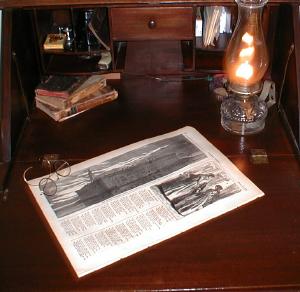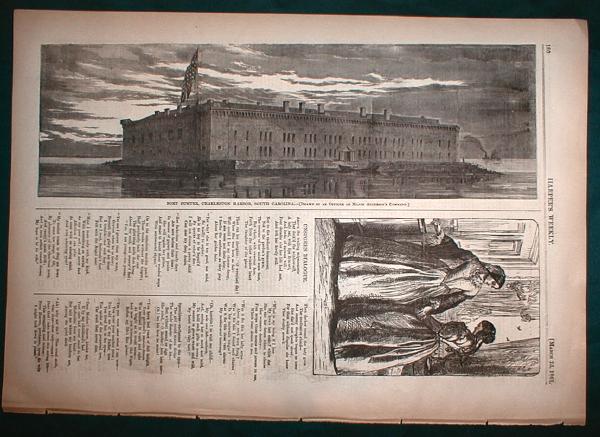Fort Sumter
![]()
This Site:
Starting a Collection
Top Picks
Online Gallery
Search Page
Order
Winslow Homer
Thomas Nast
Ken Burns Civil War
Original 1861 Civil War Illustration:
Fort Sumter on the Eve of War
|
|
Fort Sumter:You are viewing an original 1861 illustration featuring Fort Sumter. It is from an 1861 edition of Harper's Weekly, the most popular illustrated newspaper of the day. Note that this is not a reprint, and I absolutely guarantee its authenticity. This leaf is over 140 years old, and the date is clearly marked on the front of the print. On the day this leaf was printed Abraham Lincoln had been elected President of the United States, and the nation sat on the eve of the first battle of the Civil War.
|
|
This is a striking illustration of Fort Sumter as it appeared days before the opening shots of the Civil War. Fort Sumter, at the mouth of the harbor of Charleston, South Carolina, is famous as the scene of the first act of war in the American Civil War.After it became clear that Abraham Lincoln had won the presidential election of 1860, South Carolina passed an order of secession on December 20. Six days later Major Robert Anderson, commander of the Union forces at Charleston, moved his small garrison from Fort Moultrie, also in the Charleston Harbor, to the unfinished, ungarrisoned Fort Sumter, farther from shore and less vulnerable to land attack. Governor Francis Pickens of South Carolina demanded the surrender of Fort Sumter; Anderson refused. On January 9, 1861, the Union merchant vessel Star of the West attempted to land supplies and reinforcements for Fort Sumter, but was fired on and withdrew. By the time Lincoln took office on March 4, six more states had seceded, and Fort Sumter was one of the two Southern forts remaining under Union control. Lincoln was faced with either recalling Anderson or risking war by providing him with supplies and reinforcements. After much agonizing, Lincoln notified Pickens on April 8 that an attempt would be made to send provisions, but no troops or ammunition, to Fort Sumter, then in danger of being starved out. Three days later General Pierre G. T. Beauregard, under orders from Confederate President Jefferson Davis, demanded evacuation of the fort. Anderson stated that he would evacuate only if he received neither provisions nor instructions from the federal government by noon on April 15. This answer proved unsatisfactory, and at 4:30 AM on April 12, Fort Johnson in Charleston fired the first shot of a 34-hour bombardment, ending all negotiations and marking the beginning of the Civil War. Lincoln's relieving fleet arrived the same day but could not enter the harbor because of cannon fire from the shore. Anderson surrendered the fort on April 14; neither side suffered any casualties. The following day the United States declared war on the Confederacy. This is a particularly collectible print, because it shows the fort just days before the opening of the Civil War. The stars and stripes are shown flying proudly over the fort. This is a rather somber picture of the fort, as if the artist knew of the full trauma the nation was about to endure. This piece will make an excellent addition to your collection, or wonderful gift for any Civil War buff. Unlike newsprint of this century, these older, original pages do not yellow and fall apart. The reason is that modern newspapers use an acid based process. Remnant acid in the paper causes the paper to quickly yellow and deteriorate. A different process was used in the mid-1800's which yielded an exceptional quality paper that will last for centuries. Special acid free mats should be used when you frame this piece to ensure that it will last another 150 years. Acid free mats are available at most better frame shops. If you have any questions related to handling or framing this piece feel free to email me. The print is approximately 11x16 inches. I have been collecting Civil War Newspapers for over 10 years. It is a fascinating hobby, and I find that these pieces really get noticed when framed and displayed. The leaf is in very good condition. It has the rich sepia toning that you expect in original material from this period. It has a few areas of light foxing, and a few finger smudges in the margins. |
|
![]()
|
Email us at: paul@sonofthesouth.net. Copyright © 2003-2018 Son of the South.
|
|
|
|
Are you Scared and Confused? Click Here to read My Snake Story, a story of hope and encouragement, to help you face your fears. |
||

